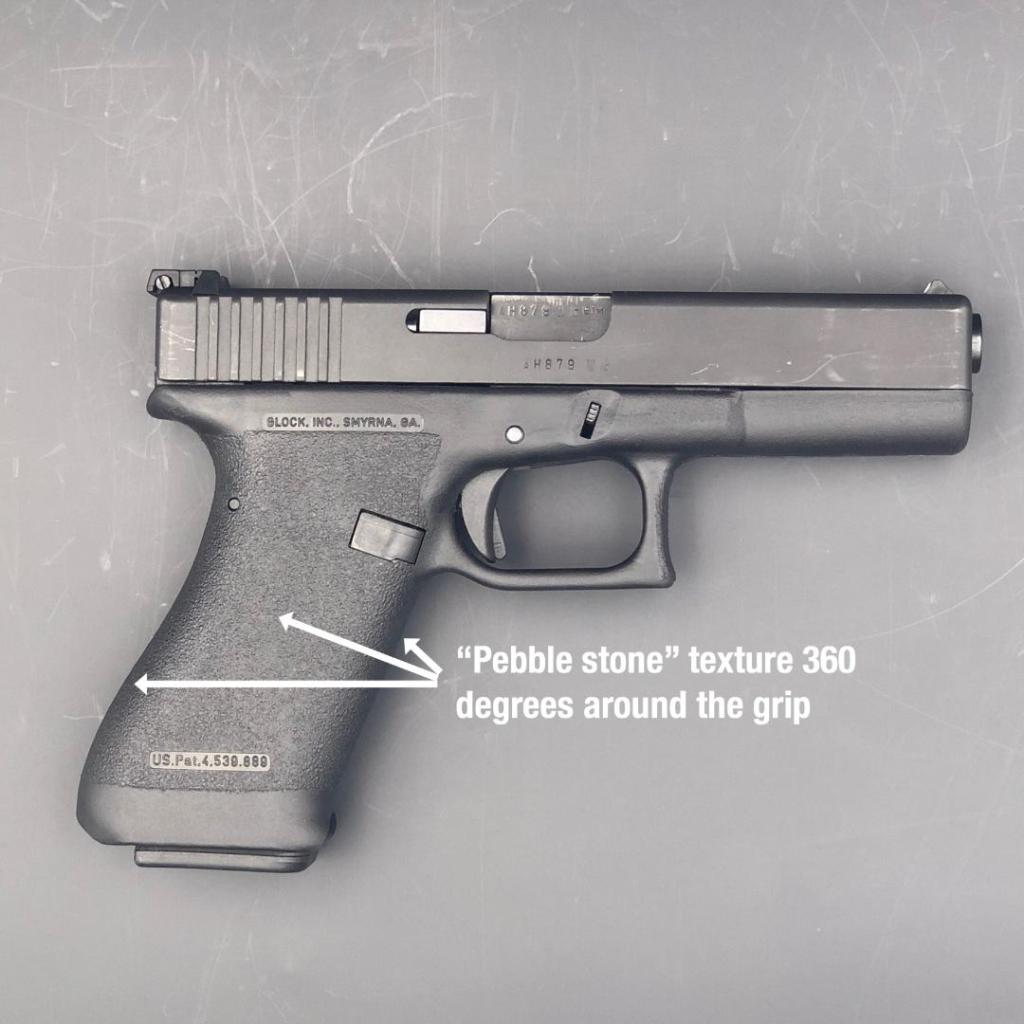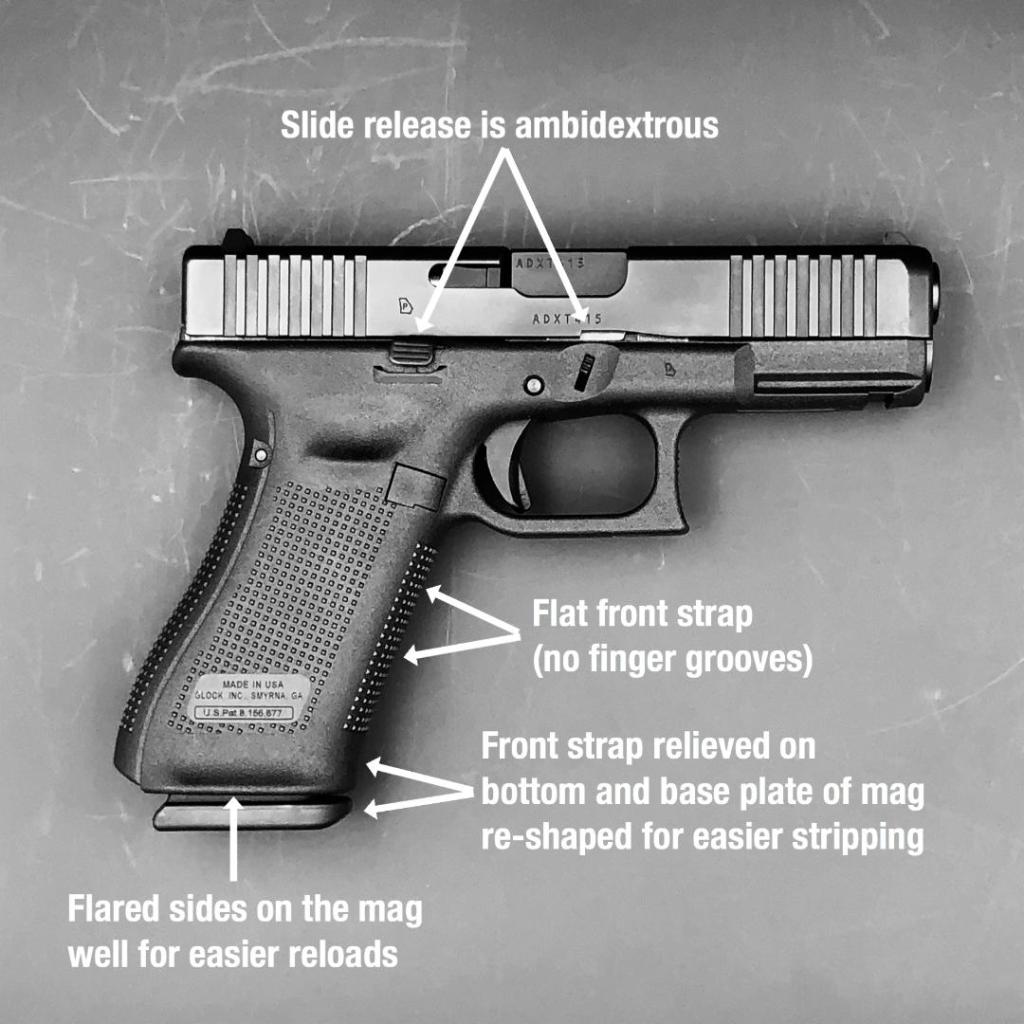Let’s clear up the confusion…
A very common question for new Glock buyers is “What Gen is my Glock?” Prior to the release of the 4th generation, Glock did not officially recognize any more than model numbers, contributing to the notion that “A Glock is a Glock is a Glock–They’re all the same.” But early collectors noticed the differences and informally settled on three major iterations, or “generations,” by which to classify. The nomenclature became so common that Glock followed suit with the release of Gen 4 in 2008 and their promotional literature now highlights earlier Gens in some places.
The pics below will help you clearly identify which generation your Glock is a part of, but note that there is a great deal of overlap as models were transitioned slowly. Also, 3rd gen guns are still in production due to California’s handgun restrictions so you could have a gen 5 gun that is actually older than your gen 3! The notes on the pics identify the major characteristics that are consistent throughout the generation, but small changes to markings and internal parts can be found at different intervals–and sometimes back and forth–within the same Gen. Thus the hard breaks between generations only designate significant frame revisions, with many parts being interchangeable across two or more, but some changes only lasting through a short run within a generation.
Gen 1

The 1st generation was one of constant change. The initial design, while reliable, was still under development. The one consistent feature is the grip texture that wraps around the entire grip (no front or back strap checkering). It’s a smoother feel compared to later gens and has been deemed the “pebblestone texture” by collectors. Early guns featured a slimmer, stainless steel barrel with parkerized finish being introduced early on (no later than AD prefix) and the barrel wall thickness being increased no later than AN prefix. Several variations exist in magazine, case, and small internal parts as well. All guns will have Austrian proof marks, but not consistent placement or number of marks. Very early (pre-US) guns and those designated for European markets do not have a serial number plate in the frame. Most early guns were also fitted with target sights that have come to be called “Weakend Sights” because of their fragility. Standard (fixed) sights are also period correct, though the target version will fetch a premium. All frames had a half-moon mag well relief in the bottom of the front straps except the few 19s that were made.
| Models | 17-19 |
| Production Span | 1982-1988 |
| Calibers | 9×19, 9×21 |
| Common Characterics | Pebblestone Texture |
| 2-pin Design | |
| Smooth Dust Cover | |
| Mag Well Relief |
Gen 2

The 2nd Gen is what many novice collectors or even un-informed dealers will refer to as a “Gen 1.” The confusion stems from two factors: 1. 1st Gens are very rare and many casual observers may not have seen one before. 2. Many models were introduced in the 2nd Gen line and some consider them to be “1st Gen” because it is the first issue of that particular model. To clear things up, if you have a model 20 or higher, you have a Gen 2 Glock even though it’s the first version of that gun made. The clear distinguisher between 1 and 2 for models 17-19 is that checkering was added to the front and back strap as well as the change to the texture of the side panels (deeper than the 1st Gen). Gen 2 also saw the introduction of 5 additional calibers and all non-.380/9mm guns were fitted with a second locking block pin to prevent frame cracking from heavier recoil. It’s important to note that the number of pins DOES NOT designate generation, as many believe. 9mm frames only have two pins from Gen 1 well into the Gen 3 production while all other calibers will have 3 pins. All full size frames carried over the mag well relief at the bottom of the front strap.
| Models | 17-33 |
| Production Span | 1988-1998 |
| Calibers | 9×19, 9×21, .357 SIG, .40 S&W, 10mm, .45 ACP |
| Common Characterics | Side Grip “Panels” |
| Checkered Front/Back Strap | |
| Smooth Dust Cover | |
| Mag Well Relief |
Gen 3

By the late ’90s, Glock had become a dominant force in the American gun market and other manufactures were scrambling to copy the design. This led to some pressure to “innovate” the Glock design to try to keep ahead of the pack. The Gen 3 changes actually started with the release of sub-compact models in 1995. It was believed that the grip would be too small for many to hold on to so finger grooves were molded into the front strap to try to increase purchase and stave off rotation due to recoil. This started a 3 year period of transition until the full changes reached all models in ’98. Some of the larger frame transitional models are quite rare (especially in ported variations)–see https://glockhistory.com/transitional/ for more info. A Gen 3 will feature front strap finger grooves, thumb rest indents at the top of the grip and an accessory rail molded into the dust cover. As mentioned above, for 9mm calibers ONLY, you will still find 2-pin designs during the early Gen 3 run. The frames were streamlined to all 3-pin in the early 2000s.
| Models | 17-39 |
| Production Span | 1997-Present |
| Calibers | .380 ACP, 9×19, 9×21, .357 SIG, .40 S&W, 10mm, .45 GAP, .45 ACP |
| Common Characteristics | Finger Grooves in Front Strap |
| Accessory/Light Rail | |
| Thumb Rests |
Gen 4

By the time the 4th generation rolled out, Glock had become ubiquitous for “handgun” but again found itself facing challengers with more innovative designs. One of the fads that caught on with consumers was having interchangeable back straps to better fit the grip to various hand sizes. Glock first experimented with narrower grips in the Gen 3 SF models (these were only available in .45 and 10mm calibers). The modular backstrap system brought SF proportions to all the frames with two up-sizing options and even beaver tail adapter inserts. The internals were re-designed from the ground up and were actually built with the .40S&W recoil profile in mind then scaled down for 9mm (where Gen 1-3 had been designed the opposite way). This should prove to make the .40 models more durable while continuing the legendary reliability of the 9s. The grip texture was also changed to a more aggressive pattern on the side panels–this, again, was first experimented with in a short run of late Gen 3 guns with the so-called “RTF2” texture. RTF2s are technically Gen 3, perhaps Gen 3.5 and were only produced (other than period special editions) from 2009 to 2011–see the picture at the bottom of this page.
| Models | 17-41 |
| Production Span | 2008-Present |
| Calibers | .380 ACP, 9×19, 9×21, .357 SIG, .40 S&W, 10mm, .45 GAP, .45 ACP |
| Common Characteristics | Finger Grooves in Front Strap |
| Accessory/Light Rail | |
| Thumb rests | |
| Modular Backstraps | |
| Pyramid Texture |
Gen 5

The first Gen 5 models were actually preceded by the release of new subcompact slim-line models 42 & 43. These models started as ground up redesigns with all new internal components to accommodate for the smaller dimensions and the FBI played a role in these changes rolling out to the larger guns with their request for M models. Models 19X, 42, 43, 43X, 44, 45, and 48 technically do not carry a Gen 5 designation on the slide, but neverless most closely align with the other Gen 5 guns. The 17 and 19 were officially released as Gen 5s in 2017 and have been followed by the other 9mm and .40 S&W offerings but thus far no .357 Sig, 10mm or .45 ACP offerings have been produced. The major changes of note include the “marksman” barrel, fully ambidextrous controls, flared magwell, and removal of the front strap finger grooves.
| Models | 17, 19, 19X, 22, 23, 26, 27, 34, 35, 42, 43X, 44, 45, 48, Also MOS versions |
| Production Span | 2017-Present |
| Calibers | .22 LR, .380 ACP, 9×19, .40 |
| Common Characteristics | Finger Grooves in Front Strap |
| Accessory/Light Rail |
Non-Conforming


There are (at least) two more designs that might be encountered that actual fall out of the generational distinctions or are different enough as to be hard to identify from the above discourse: 1. RTF2 third Gens & 2. The FBI M-series.
RTF2 is short for “rough texture frame, second version.” The first version was only made as a prototype and never released although at least one is on exhibit at the Cody Firearms Museum. The designers landed on the second version and new molds were made to incorporate this grip texture into a standard 3rd Gen design. All the internal parts are the same so the only difference will be the texture of the grip. As you can see from the exploded pic, the entire grip is covered in little pyramids–and let me tell you, they are sharp! This gun will really stick in your hand, even when wet. Glock marketed these mostly to police from 2009 to 2011 but the design is a clear stepping stone between third and fourth generation guns. The pyramid concept was carried forward but with larger pyramids as the RTF2 ones were prone to wearing off and also wearing through clothing. See https://glockhistory.com/rtf2g/ for more pics.
Finally, we should also talk about the FBI’s M series pistol. The 17M & 19M actually preceded and, perhaps, inspired Gen 5 guns. They were built to specifications requested by the FBI as a new department service weapon and incorporated some of the design changes from the mini 42/43 models as well as some new ideas. These were the first Glocks with ambidextrous controls and changes to the rifling designed to improve accuracy. On the outside though, the M gun is going to look and feel almost exactly like a Gen 5–the main differences being internal so most collectors would consider them to be part of the Gen 5 family. To the right person, however, that “M” added to the model marking will make a lot of difference in the price they are willing to pay.